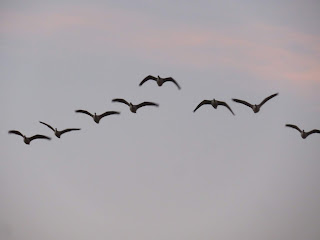The bosque is remaining remarkably free of animals right now, but that's okay. Everything leaves a story from its passage through life. So it goes, as Vonnegut would say.
One of the bad things about the internet is that it can be hard to find your niche. There are a million pictures of sand hill cranes out in the digi-verse and most are spectacular. But THIS picture is mine, and documents the first sighting by me of cranes in our neighborhood, so it is the best for that purpose. The cranes are attracted by the locale...but also by someone who is feeding them, too. I suspect their numbers are not going to be great this year, but that is also fine. The acres of Bosque del Apache are managed almost exclusively for the use of these big birds and that is where you should go to see the jaw dropping numbers attracted by a perfect habitat.
I think this is honeysuckle, which is a very unusual plant. The delicate blossoms are still on the plant, and they seem to perk right up when cuttings are brought into the house...
Humans have long had a connection with soil. We really don't in these times, but it is still fascinating to feel it beneath our feet. Usually it is hard packed and dry, but sometimes you can get a sense of the potential of this interaction of sand, clay, humus, air and water we call dirt when you walk those areas less trod. This ditch has been dry for a while, but the area just below the dry surface is still wet, and this allows lubricity for the grains of sand and clay to slide when they are walked on. Basically, you sink a little.
This picture is trying to show the imprint where a carp died and left scales and bones in a messy jumble. This is the first stages of the aeons long process of fossil creation. If this skeleton is then covered by a fine silt to preserve detail, one day a future blogger might find a fish fossil in a badlands formation. Those degraded proteins form nitrates after being acted on by bacteria and return to the plants.
The salt crystals left by the alkaline waters of the clear ditch form roughly hexagonal cracks as they lose water. Crickets survive in these moist micro-climates and are often heard late into the evening even on pretty chilly nights.
The turtles are often the last species to abandon a ditch de to lack of water. Often, they are predating on the stranded fish. Like most animals, they eat what is available. Distinctions between herbivores and carnivores are lessons best left behind in the high school classroom. Their distinctive trails show in the stream beds and is where the water will flow as the levels rise again, which they have already begun to do, (slowly).
This plant bug was just a random picture I took for general interest. I had not expected the little heart shape on the middle of the back. The magnified world of bugs is endlessly fascinating and even with the cold weather, is showing no signs of stopping.
The jumping spiders are very active right now outdoors. They come in many shapes and sizes and are incredibly fun to watch. Their eyes are highly evolved for distance and jumping so they seem to have very anthropomorphic attributes, like startling reflexes, aggression, and examining new situations. The usual disclaimer; totally harmless to humans, obviously.Large flocks of crow roost in the trees of the bosque. They are found in flocks anywhere they can roost in large numbers above the ground. There are also ravens, but they are very different in habits and temperament. Grackles stay closer to human habitation, but starlings prefer trees in open fields.

















No comments:
Post a Comment